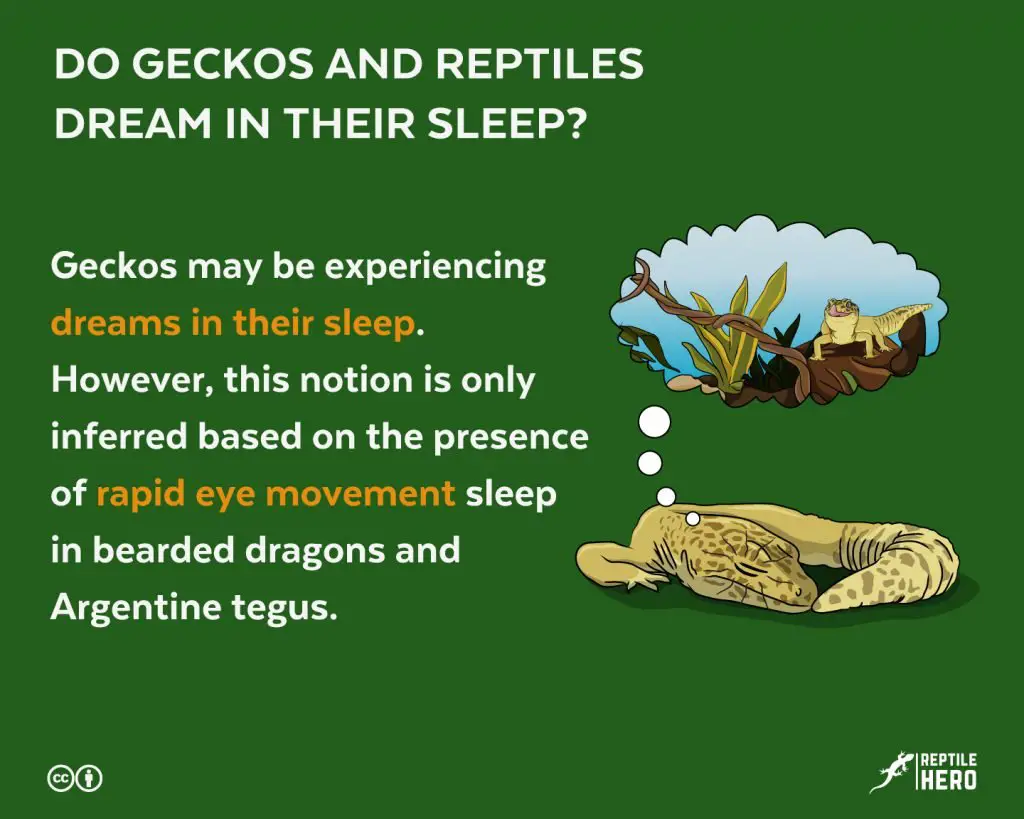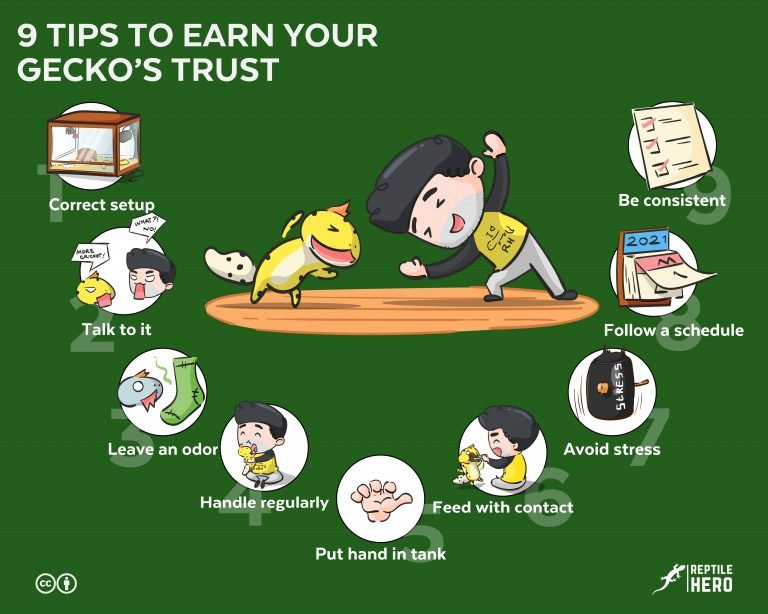Do Geckos and Reptiles Dream in Their Sleep? [What Science Says]
Have you ever wondered whether your geckos dream? Apparently, you have no way to know for sure if they are lost in the world of fantasies. However, scientists have recorded interesting and resounding pieces of evidence, pointing out that animals—including reptiles—do dream!
Geckos may be experiencing dreams in their sleep. However, this notion is only inferred based on the presence of rapid eye movement sleep in bearded dragons and Argentine tegus. Nevertheless, many owners firmly believe that their geckos are capable of dreaming.
If you are itching to know whether those twitches while your gecko is sleeping is part of its dream, let us get into it.
Before we dive into it, let me tell you this.
The most vivid dreams occur when the brain is most active, and the body enters the phase called rapid eye movement (REM) sleep. So, it is vital to look for this stage when attempting to understand dreaming in reptiles!
The Truth Behind Geckos’ Dream
As early as the 1950s, scientists have revealed from their early studies that animals (like cats) dream and share a similar sleep pattern with us. As we became more interested in our mammal pets, we demanded more answers to our queries. So, scientists conducted more studies, and we got to know our furry friends better.
Meanwhile, having reptiles—especially geckos—as pets is not as mainstream in the past as it is now. In addition, studying reptiles has never been as easy as observing mammals back in the day when technology was limited.
Both factors, among others, contribute to inconclusive information available for us to better understand our scaly friends. However, findings from two recent reptile studies have made headlines as our scientists go to great lengths to gain greater knowledge of our beloved reptile pets. Unfortunately, neither of these are specific to geckos, but these can give us an idea!
Research #1: The Dragon Dozes Off Like You Do (Maybe)
There have been multiple studies as early as the 1960s that report the existence of REM sleep in reptiles. Regrettably, the right technology to give decisive conclusions was just not there. As a result, none of them persuaded the scientific community.
Despite our effort, we did not find anything especially related to geckos. However, Shein-Idelson led one of the first studies in 2016 that documented lizards sleeping in stages [1].

The Modern Technique
The modern technique involved neuronal documentation, or recording neuron movements, which briefly followed these steps:
- Preparation: The team performed surgery on five bearded dragons (Pogona vitticeps). The researchers inserted linear silicon probes or tetrode arrays in the dorsoventricular ridge and cortex of the dorsal forebrain.
- Pre-observation: The team verified the placements of the electrodes using two modalities (CT scan and MRI).
- Observation: The team recorded the dorsal forebrain’s extracellular electrical activity. This is expressed as local field potential, including multi- and single-unit activity. The recording focused on the middle of the night, though it lasted for 18 to 20 hours.
- Monitoring: Along with the electrophysiological recording, the team kept an eye on the lizards’ behavior while asleep.
- Repetition: The observation and monitoring were repeated for many weeks to gather data for analyses and interpretation.
The Findings
In the milestone research, the group conducted neuronal recordings to observe the brain activity of bearded dragons. The team’s finding has provided proof that dragons enter many sleep stages similar to humans.
Specifically, the 4 stages of sleep that dragons go through are:
- ripples
- REM sleep
- sharp waves
- slow-wave sleep
This stunning piece of information was novel since it was the first time that scientists studied and recorded the brain activity of sleeping reptiles, specifically lizards.
The Meaning of the Findings
“So what if dragons go through the same sleep stages as us?” you might wonder. Recall that REM sleep has been associated with dreaming in human studies. The brain finds a way to perceive the many random signals it obtains under this state.
While the study has not explicitly stated that dragons do dream like humans, the presence of REM sleep implies that dragons could experience dreaming, just as some scientists believe.
The Drawback of the Implication
Although some scientists support the idea that dragons dream like humans, just by basing solely on the presence of REM sleep in their cycle, other scientists would say otherwise.
One of the scientists skeptical of this notion is Laurent, a member of the team. He expressed that the somewhat arbitrary correlation may not have solid grounds for the premise. Furthermore, he added that even though bearded dragons possess neural experiences akin to us, these events may not suffice to say that they experience the intricate dreams as we do.
However, he later remarked that if we can believe and call the chunks of ‘neuronal playback’ in specific parts of their sleeping brain as dreams, he can say that lizards indeed dream like us.
Research #2: The Tegu Does Not Sleep Like the Dragon
The new understanding of sleeping (and possibly dreaming) in bearded dragons has sparked interest in other researchers in subjecting other lizards to similar experiments.
In 2018, a group of French scientists from Claude Bernard Lyon University initiated another sleep study on bearded dragons and, for the first time, on Argentine tegu (Salvator merianae) [2]. What do you think they find out?
The New Findings
Before recording the electrophysiological activity of Argentine tegu, the team first replicated the novel dragon experiment to another dragon. By doing this, they could prove the reproducibility of the research method. Afterward, they proceeded to conduct the investigation using another lizard species.
The data from the innovative investigation verified that bearded dragons enter the slow-wave and REM sleep cycles. It also confirmed that Argentine tegus go into the two sleep states—just like humans—but in a distinct manner.
However, the new information does not stop there. The same sleep experiment that analyzed behavioral, cerebral, and physiological parameters has exposed two differences.
- The first difference: Cerebral activity. In the equivalent phase of sleep, bearded dragons have similar cerebral activity during waking hours. Meanwhile, Argentine tegus do not resemble any similarity of cerebral activity to waking hours.
- The second difference: Eye movement. Both lizards have slower eye movements when they enter the corresponding state of human REM sleep. However, humans have ocular activity similar to when awake.
The Meaning of the Findings
The validated results of the research method used electrophysiological signals. The consistent observations in bearded dragons from the two groups of scientists strengthen the claim that these lizards may dream because REM sleep exists in their sleep cycles.
However, the pattern differences observed between bearded dragons and Argentine tegu were not anticipated. Thus, it paints a more multifaceted picture of REM sleep in animals. So, new opportunities can be explored for investigations into the origin of sleep patterns and dreams of geckos!

What is the Final Verdict?
In reptiles, the findings of REM sleep become more complex after dissimilarities between bearded dragons and Argentine tegus. In effect, the exact mechanisms affecting or involved in reptile REM sleep and dream production still remain unknown.
In addition to the differing expression of (assumed) REM sleep states in dragons and tegus, many other traits associated with REM sleep in mammals and birds were either not found or not fully expressed.
Other factors were not investigated or could not be expressed. These said traits include:
- complete atonia or loss of muscle strength
- Homeostasis or internal stability
- loss of thermoregulation
- twitches
Thus, it is still unclear whether reptiles:
- have a mammalian REM sleep-like state (having the same function) but inversely expressed
- have a partial mammalian REM sleep-like state
- have another sleep state supporting other functions
What Gecko Owners Witness
As more people start to keep geckos as pets, owners have become curious about how they behave, like chasing lasers and doing tricks. You might even be one of them that wonders whether they dream, too.
While the results of modern studies only suggest the notion of gecko dreaming, some owners have happily shared (with conviction) their experiences with their dreaming geckos.
Story #1: A Surprise Bite Attack
While science still cannot say for sure (and is doubting about the idea) that geckos dream, one owner I talked to was sure to have witnessed her gecko dream. She recalled the event by explaining how it started.
She told me that her crested gecko stayed on her chest, which was one of those unusual days. Eventually, her gecko fell asleep. As if sleeping soundly, it moved its head and twitched its legs.
What came next surprised her as the gecko leaped into her hand and bit her finger without warning. She then added that the act certainly felt like her pet just had a vivid dream of hunting down an insect, mistaking her finger for it.
Story #2: A Moving Tail
A gecko tank should be filled with decorations—like blankets, hammocks, and woods—for the pet to feel comfortable, entertained, and safe. This is what one of the friendly pet owners did with hers. However, she noticed something odd in one of her crested geckos!
She reported that in an enclosure this particular female gecko hid inside a paper tube with only her tail stuck out at the end of the hole. There were no movements as everyone was quietly sleeping.
However, all of a sudden, her tail started to wiggle slowly like an S. Despite the owner not seeing the gecko’s face, she was pretty sure that the gecko was sleeping (and dreaming) as no other activity was visible.

Takeaways
Researchers have confirmed in recent studies that lizards, specifically bearded dragons and Argentine tegus, may dream because of the presence of the REM sleep stage. However, the processes involved are still unclear.
With the findings of the 2016 and 2018 studies, it can only be presumed that geckos dream as well. However, several anecdotes from many gecko owners argue that their pets experience dreaming.
Sources
[1] https://science.sciencemag.org/content/352/6285/590
[2] https://www.sciencedaily.com/releases/2018/10/181011143059.htm






